JAPANESE SWORDSWOMEN II:
FEMALE COMRADES, FEMALE FOES
In Japanese swordswomen films it is not uncommon that an additional/secondary swordswoman appears in the story, so that heroic female figures do not appear to be isolated cases in otherwise male-dominated worlds. This places chambara far American martial arts films & female swashbucklers wherein the rare fighting woman is shown to be an anomaly.
In the series that began with Crimson Bat: The Blind Swordswoman (Mekura no Oichi Monogatari: Makkana nagaradori, 1969), Yuko Matsuyama interacts with other actresses in fighting roles. Oichi meets Omon, a glamorous gambler who fights with chains, played by Chizuki Akai.
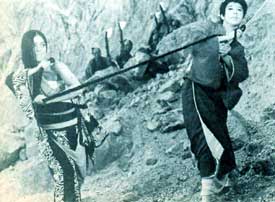 In the immediate sequel Trapped, The Crimson Bat (Mekura no Oichi jogokuhada, 1969) the co-star is Kikko Matsuoka as an impressive hoodlum named Oen who who fights with a whip made from human hair. In another of the series, Oichi is pitted against a woman expert in knife-throwing. In the immediate sequel Trapped, The Crimson Bat (Mekura no Oichi jogokuhada, 1969) the co-star is Kikko Matsuoka as an impressive hoodlum named Oen who who fights with a whip made from human hair. In another of the series, Oichi is pitted against a woman expert in knife-throwing.
When swordswomen meet, they needn't be enemies, though in the Crimson Bat series they usually are. In The Red Silk Gambler aka Tiger Lily (Hichirimen Bakuto, 1972) starring Eiko Nakamura, there are two secondary swordswomen, all three achieving a close friendship of trust & honor.
Many Japanese films (even those about love or domesticity) have this underlying theme that women can trust only other women (discounting the unreliable mother-in-law) whereas men are as rule untrustworthy, whether from cruelty or neptitude. In female yakuza films this attitude may in part mimic the standard male-yakuza theme of men's friendship being the most beautiful for men.
There is a strong even if subliminal eroticism about such male friendships which is not quite as overt in themes of female friendship. This may be because there are mere practical as opposed to sensual reasons for women to be united, as in the film Ballad of Orin (Hanare Goze Orin, 1977) wherein blind women band together as nun-musicians, knowing that if they travelled singly they'd be at the mercy of men.
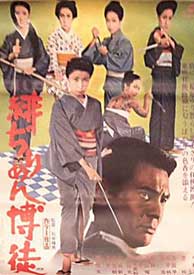 One of the two secondary swordswomen of Red Silk Gambler is, once again, a blind fighter named Mon or Omon, whose performance is one of the best tear-jerkers of all gangster cinema. Mon's fighting methods include the clever trick of spilling round bells out of a bag so that a large number of attackers will give their positions away when their footwork rolls the bells, & she cuts them immediately. One of the two secondary swordswomen of Red Silk Gambler is, once again, a blind fighter named Mon or Omon, whose performance is one of the best tear-jerkers of all gangster cinema. Mon's fighting methods include the clever trick of spilling round bells out of a bag so that a large number of attackers will give their positions away when their footwork rolls the bells, & she cuts them immediately.
Although Red Silk Gambler has been categorized "pinky violence" -- an area of Japanese cinema that mixes mixes nudity, sadism & swordplay -- this categorization seems to have come about more because director Teruo Ishii did direct many such films, with titles like The Shogun's Joy of Torture (Tokugawa onna keibatsushi, 1968), Orgies of Edo (Zankoku ijŲ gyakutai monogatari: Genroku onna keizu, 1969), or most blatantly Porno Period Drama (Poruno jidai-geki: Bohachi bushido, 1973).
The expectation of the director is easily reinforced because too few people have had the opportunity to see Red Silk Gambler which long fell out of circulation after its initial release. But really Ishii started out his directing career as an acolyte of low-key archly tasteful Miiko Naruse. He's capable of vastly much more than pinku, having done everything from children's science fiction films (notably the Super Giant aka Starman series) to the groundbreaking Abashiri Prison yakuza series.
And then approaching the end of his long career he went totally avant garde proving you're never too old to be amazing in entirely new ways, his Blind Beast vs. Killer Dwarf (Moju tai Issunboshi, 2001) being one of the most bizarre independent features of all time.
Beautiful bloodletting swordswomen may be inherently sexy stuff but like Junko Fuji as the Red Peony Gambler or Kaji Meiko as the gorier but still respectfully treated Lady Snowblood, Eiko Nakamura as Tiger Lily is presented in a context of high regard, far more dour & tasteful than Ishii's notorious woman gambler film Female Yakuza Tale: Inquisition & Torture (Asagure anego den: Sokatsu Rinchi, 1973).
Released about the same time that Fuji Junko retired, Tiger Lily was intended as the first of a series that would be of the same tone as the Red Peony Gambler films, the heroine having a lily tattoo instead of a peony. Poor box office receipts (at a time when audiences in generally were vanishing) meant the film did not launch a new series after all.
Red Silk Gambler was based on a novel by Oniroku Dan, who wrote torture tales suited to Ishii's more extreme films, & other titles based on Oniroku Dan books are softcore bondage & porn. Yet in this one case, Red Silk Gambler stands tall as a heroic tale much more than a vulgar one. It's one of the best films of its kind & it's high time someone ferreted out the rights & got it subtitled for re-release in the west -- before some smart thief locates the subtitled 35 mm print & circulates it as a grey-market dvd.
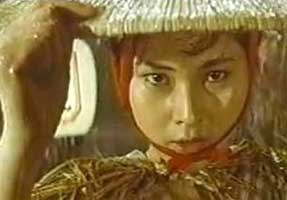 Blind swordfighters are a commonplace of samurai & yakuza cinema, long predating the famous Zatoichi series, & quite a number of these blind fighters are women. The final scene of Teruo Ishii's The Tattooed Swordswoman aka The Blind Woman's Curse aka Black Cat's Revenge aka The Haunted Life of a Dragon-tattooed Lass (Kaidan nobori ryu, 1970) is an incredible duel between (as one variant title for the film named them) The Blind Swordswoman vs. the Dragon Tattooed Lass. Blind swordfighters are a commonplace of samurai & yakuza cinema, long predating the famous Zatoichi series, & quite a number of these blind fighters are women. The final scene of Teruo Ishii's The Tattooed Swordswoman aka The Blind Woman's Curse aka Black Cat's Revenge aka The Haunted Life of a Dragon-tattooed Lass (Kaidan nobori ryu, 1970) is an incredible duel between (as one variant title for the film named them) The Blind Swordswoman vs. the Dragon Tattooed Lass.
Unlike the chummy gals of Red Silk Gambler, these two women are enemies of the most intense kind. Yet there is a sense of sadness about it being so, rather than romanticized revenge against someone bad. Both of these women are at base decent, but trapped in the codes & ethos of the yakuza world.
Akemi (Meiko Kaji, who sings the theme song) is the Dragon-tattooed Lass, successor of the Tachibana Gang. She stands in Boss Goda's path announcing politely that hers is a revenge raid. She & her men throw their rain hats straight up in the air. Her men reveal their body tattoos, & the mass-swordfight's engaged behind opening credits.
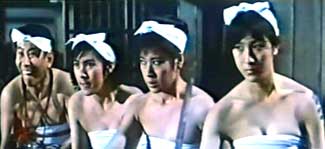 When Akemi's men stand shoulder to shoulder, they have one continuous dragon tattoo across their backs! Later when Akemi's in prison, a group of five of her prison mates get similar fragments of a great snake-tattoo in her honor, the theme again of women bonding with women as Akemi finds herself with a defacto girl-gang without even trying to start one up. When Akemi's men stand shoulder to shoulder, they have one continuous dragon tattoo across their backs! Later when Akemi's in prison, a group of five of her prison mates get similar fragments of a great snake-tattoo in her honor, the theme again of women bonding with women as Akemi finds herself with a defacto girl-gang without even trying to start one up.
After they're all out of prison, the women committed to Akemi begin to be killed one by one, & skinned of their tattoos, so that Akemi very soon realizes there's someone on a very, very grim vengeance trail against her.
In that opening battle, a young woman ran out into the melee to protect her father, who may have been a bit stinky bad guy, but girls do love their daddies. Akemi accidentally slashed the young woman across the eyes. As she lay on the ground pressing fingers to bloody eyes, a black cat lapped blood from her face, which in Japanese folklore links victim & cat in a supernatural bond, dark powers generally focused upon revenge.
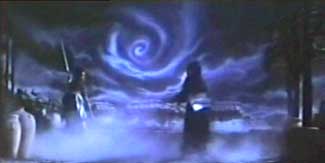 The blinded Aiko Goda is played by Hiroko "Hoki" Tokuda, who in real life used her charms to get shitloads of money & presents out of Arthur Miller while refusing to have sex with the horny old fart, though some masochistic part of him must have enjoyed being taken, as the marriage lasted a decade. The blinded Aiko Goda is played by Hiroko "Hoki" Tokuda, who in real life used her charms to get shitloads of money & presents out of Arthur Miller while refusing to have sex with the horny old fart, though some masochistic part of him must have enjoyed being taken, as the marriage lasted a decade.
Hoki is eternally commemorated in Letters from Arthur Miller to Hoki Tokuda (1986). With a natural "bedroom eyes" look of extreme & sexy nearsightedness which adapts well to a blind villainess. There are few women in the whole darned world as beautiful as Kaji Meiko, but Hoki Tokuda definitely looks good. Her attempt to use notoriety rather than talent to become a movie star never quite paid off, though, & when she & Miller finally divorced, she used her part of the settlement to start a nightclub called Tropic of Cancer which catered to yakuza & neo-hipsters.
In prison, Akemi is known only as No. 36, & suffers nightmares of having blinded that young woman. Three years later she's freed, but with a blind swordswoman holding a grudge against her, empowered by the cat's curse.
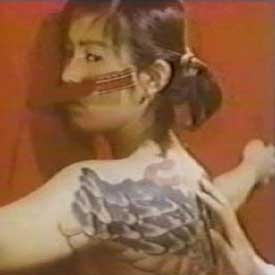 Although Kaidan Nobori Ryu isn't quite as tastefully done a chivalry-&-gore tale as is Red Silk Gambler, it comes close, & treates Kaji Meiko's character with all due respect, notwithstanding that Kaji Meiko can't help being awfully sexy. Although Kaidan Nobori Ryu isn't quite as tastefully done a chivalry-&-gore tale as is Red Silk Gambler, it comes close, & treates Kaji Meiko's character with all due respect, notwithstanding that Kaji Meiko can't help being awfully sexy.
To great extent this film bridges two types of films from Teruo Ishii, the "normal" yakuza films of the Abarashiri Prison series inclusive of the Tiger Lily woman gambler film, & the off-the-wall fantasies of torture or journeys in hell, as in his infamous Jigoku (Hell! 1999).
Thus it swings from a mannered tale of yakuza codes & ritual behavior, to a veritable freakshow taking place partially in a carnival & a climactic battle in a spooky environment reminiscent of Jigoku.The blind swordswoman has a circus act as a knife-thrower & Akemi becomes her "target" in one of the high-tension scenes.
Then there's the odiously Ishii-esque sequence with the dancing hunchback, played by Tatsumi Hijikata, a famed jazz dancer whose performances were marked by "perverted violence" or "ghost-like & demonic." Kaidan Nobori Ryu is a rare opportunity for westerners to see the late dancer who some found so alarming during his lifetime.
It's not in all regards a successful blend of woman-yakuza & horror film, but certainly it is always interesting. And that final duel in what looks like a hell-world of Aiko's psychosis manifesting in the physical world is well worth all patience.
It might be tempting to suppose that blinded or otherwise crippled swordswomen on some level symbolize women's restrictions in society, & the great women who overcome the limitations imposed upon them.
But of course these films actually emulate films about blind or crippled men, not just blind Zatoichi of greatest fame, but the much earlier Ryunosuke Tsukue first played by Denjiro Okochi (1935) & later by Cheizo Kataoka (1957-1959) then by Raizo Ichikawa (1960-1961).
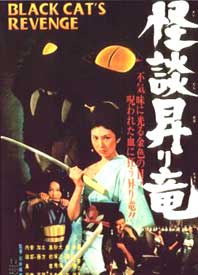 He was played once more by Tatsuya Nakadai in Sword of Doom (Daibosatsu toge, 1966), but the story cuts off before Tsukue is blinded. So too The One-Eyed One-Armed Swordswoman Onna Sazen, 1969) is overtly in homage to a standard chambara hero who'd been around since the silent film era. He was played once more by Tatsuya Nakadai in Sword of Doom (Daibosatsu toge, 1966), but the story cuts off before Tsukue is blinded. So too The One-Eyed One-Armed Swordswoman Onna Sazen, 1969) is overtly in homage to a standard chambara hero who'd been around since the silent film era.
At first glance it may seem absurd that blind men & women can be great swordfighters according to such films as these, but in terms of martial realism the blind warrior is not entirely absurd.
Even European history had its Jan Ziska the blind warrior of medieval Bohemia. As fir the highly formalized fighting methods of Japan, iaijutsu & iaido swordstyles are practiced "sets" designed to meet the needs of most battlefield encounters & duels. Classical samurai practiced in total darkness or blindfolded, training his ear more than his eyes in these forms, & relying heavily on speed & balance.
And Japanese women, especially of the samurai class, practiced were almost universally skilled at least with halbard or naginata largely regarded as a women's weapon. With sword or halbard women practiced night-fighting in order to defend the rooms & hallways of homes & castles after first extinguishing all the lights.
So even the sighted were expected to have some skill with the sword or other weapons even though blind, & while the abject invincibility of of Blind Oichi or a Zatoichi is obviously fictional exaggeration, it is not abject fantasy.
copyright Š by Paghat the Ratgirl
|
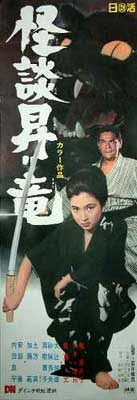
 In the immediate sequel Trapped, The Crimson Bat (Mekura no Oichi jogokuhada, 1969) the co-star is Kikko Matsuoka as an impressive hoodlum named Oen who who fights with a whip made from human hair. In another of the series, Oichi is pitted against a woman expert in knife-throwing.
In the immediate sequel Trapped, The Crimson Bat (Mekura no Oichi jogokuhada, 1969) the co-star is Kikko Matsuoka as an impressive hoodlum named Oen who who fights with a whip made from human hair. In another of the series, Oichi is pitted against a woman expert in knife-throwing. One of the two secondary swordswomen of Red Silk Gambler is, once again, a blind fighter named Mon or Omon, whose performance is one of the best tear-jerkers of all gangster cinema. Mon's fighting methods include the clever trick of spilling round bells out of a bag so that a large number of attackers will give their positions away when their footwork rolls the bells, & she cuts them immediately.
One of the two secondary swordswomen of Red Silk Gambler is, once again, a blind fighter named Mon or Omon, whose performance is one of the best tear-jerkers of all gangster cinema. Mon's fighting methods include the clever trick of spilling round bells out of a bag so that a large number of attackers will give their positions away when their footwork rolls the bells, & she cuts them immediately.
 When Akemi's men stand shoulder to shoulder, they have one continuous dragon tattoo across their backs! Later when Akemi's in prison, a group of five of her prison mates get similar fragments of a great snake-tattoo in her honor, the theme again of women bonding with women as Akemi finds herself with a defacto girl-gang without even trying to start one up.
When Akemi's men stand shoulder to shoulder, they have one continuous dragon tattoo across their backs! Later when Akemi's in prison, a group of five of her prison mates get similar fragments of a great snake-tattoo in her honor, the theme again of women bonding with women as Akemi finds herself with a defacto girl-gang without even trying to start one up. The blinded Aiko Goda is played by Hiroko "Hoki" Tokuda, who in real life used her charms to get shitloads of money & presents out of Arthur Miller while refusing to have sex with the horny old fart, though some masochistic part of him must have enjoyed being taken, as the marriage lasted a decade.
The blinded Aiko Goda is played by Hiroko "Hoki" Tokuda, who in real life used her charms to get shitloads of money & presents out of Arthur Miller while refusing to have sex with the horny old fart, though some masochistic part of him must have enjoyed being taken, as the marriage lasted a decade. Although Kaidan Nobori Ryu isn't quite as tastefully done a chivalry-&-gore tale as is Red Silk Gambler, it comes close, & treates Kaji Meiko's character with all due respect, notwithstanding that Kaji Meiko can't help being awfully sexy.
Although Kaidan Nobori Ryu isn't quite as tastefully done a chivalry-&-gore tale as is Red Silk Gambler, it comes close, & treates Kaji Meiko's character with all due respect, notwithstanding that Kaji Meiko can't help being awfully sexy. He was played once more by Tatsuya Nakadai in
He was played once more by Tatsuya Nakadai in